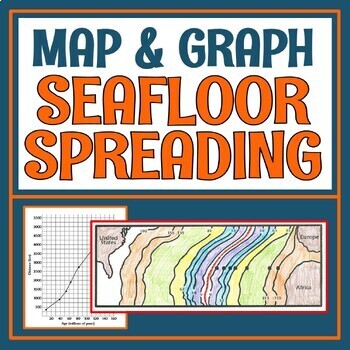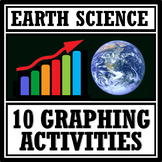Evidence of Seafloor Spreading Activity Middle School Plate Tectonics
Flying Colors Science
4.8k Followers
Grade Levels
6th - 8th
Subjects
Resource Type
Standards
NGSSMS-ESS2-3
NGSSMS-ESS2-2
NGSSMS-ESS2-1
Formats Included
- PDF
Pages
2 pages
Flying Colors Science
4.8k Followers
What educators are saying
I loved this seafloor spreading activity. The coloring aspect really helped students understand how material is cycled.
Great lab to do with students after teaching the concept pf seafloor spreading. Some students struggled with how to color using the code but other than that wondeful!
Also included in
- SAVE 30% and get 8 NO PREP activities to add ENGAGEMENT and NGSS RIGOR to your Plate Tectonics Unit! Students will learn more about plate movement, seafloor spreading, the Ring of Fire, and other plate tectonics topics. This bundle includes the following resources:Graphing Evidence of Sea Floor SpPrice $15.99Original Price $22.96Save $6.97
- Never search for "something to do tomorrow" ever again! This bundle contains PRINT AND GO lessons, NO PREP activities, LOW PREP labs, and ENGAGING articles to supplement and thoroughly enhance an Earth and space science course. Every included resource is easy to implement, standards-based, and high-Price $399.99Original Price $639.06Save $239.07
- SAVE OVER 30% off list prices! Add SCIENCE GRAPHING SKILLS PRACTICE across your Earth and Space science curriculum! Each activity addresses an NGSS Earth or Space science standard while helping students get more experience graphing data. Every resource is a little different than the next, and thePrice $29.99Original Price $44.41Save $14.42
Description
Nails home EVIDENCE that the seafloor near the mid-Atlantic ridge is newer than the seafloor near the continents.
⭐ Get this activity at a discount in our Plate Tectonics ACTIVITIES BUNDLE!
In this activity, students will:
- Color-code a diagram of the seafloor and mid-Atlantic ridge based on the age of the rock.
- Measure how far each "band" of seafloor is from the ridge.
- Graph the relationship between the age of the seafloor rock and the distance from the mid-Atlantic ridge.
- Answer follow-up questions that help students conclude that the seafloor near the mid-Atlantic ridge is newer than the seafloor near the continents.
Teacher Notes:
- Every step includes clear, middle school-level directions.
- Includes an answer key.
- NGSS Standards: MS-ESS2-1 and MS-ESS2-2
- NGSS Science & Engineering Practice: Developing and using models
- NGSS Science & Engineering Practice: Analyzing and interpreting data
- NGSS Science & Engineering Practice: Using mathematics and computational thinking
- Please note: This PDF resource is NOT editable.
- This activity complements our Mapping the Mid-Atlantic Ridge Activity perfectly!
- SAVE $$ with our Plate Tectonics ACTIVITIES BUNDLE!
You'll find lots more in the PLATE TECTONICS SECTION OF OUR STORE.
⭐⭐⭐Click here to get 5 FREE EARTH & SPACE SCIENCE lessons!⭐⭐⭐
Total Pages
2 pages
Answer Key
Included
Teaching Duration
N/A
Report this resource to TPT
Reported resources will be reviewed by our team. Report this resource to let us know if this resource violates TPT’s content guidelines.
Standards
to see state-specific standards (only available in the US).
NGSSMS-ESS2-3
Analyze and interpret data on the distribution of fossils and rocks, continental shapes, and seafloor structures to provide evidence of the past plate motions. Examples of data include similarities of rock and fossil types on different continents, the shapes of the continents (including continental shelves), and the locations of ocean structures (such as ridges, fracture zones, and trenches). Paleomagnetic anomalies in oceanic and continental crust are not assessed.
NGSSMS-ESS2-2
Construct an explanation based on evidence for how geoscience processes have changed Earth’s surface at varying time and spatial scales. Emphasis is on how processes change Earth’s surface at time and spatial scales that can be large (such as slow plate motions or the uplift of large mountain ranges) or small (such as rapid landslides or microscopic geochemical reactions), and how many geoscience processes (such as earthquakes, volcanoes, and meteor impacts) usually behave gradually but are punctuated by catastrophic events. Examples of geoscience processes include surface weathering and deposition by the movements of water, ice, and wind. Emphasis is on geoscience processes that shape local geographic features, where appropriate.
NGSSMS-ESS2-1
Develop a model to describe the cycling of Earth’s materials and the flow of energy that drives this process. Emphasis is on the processes of melting, crystallization, weathering, deformation, and sedimentation, which act together to form minerals and rocks through the cycling of Earth’s materials. Assessment does not include the identification and naming of minerals.








